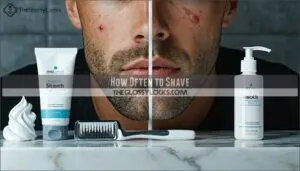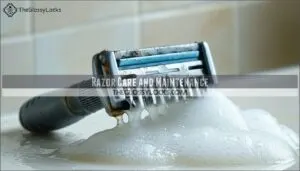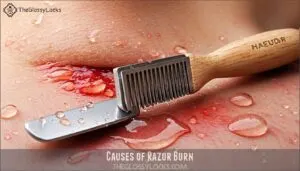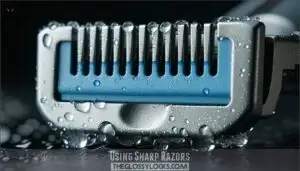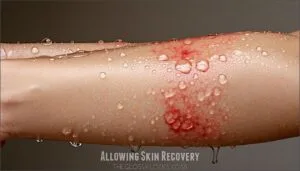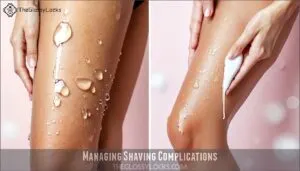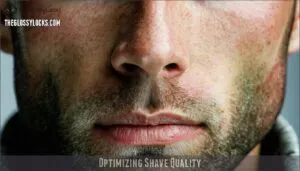This site is supported by our readers. We may earn a commission, at no cost to you, if you purchase through links.
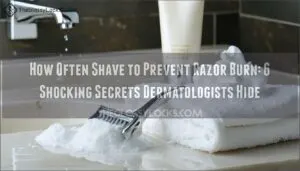
Shaving too often can irritate your skin, especially if it’s sensitive, while waiting too long can make coarse hair harder to shave.
Always use a sharp razor, shave with the grain, and lather up with a good shaving cream. Avoid dry shaving—it’s like walking barefoot on hot pavement: painful and unnecessary.
After shaving, soothe your skin with a moisturizer to lock in hydration. Timing matters too, so find the sweet spot for your skin’s comfort and keep things irritation-free.
Table Of Contents
- Key Takeaways
- Shaving Frequency Matters
- How Often to Shave
- Shaving Techniques Importance
- Preventing Razor Burn
- Managing Shaving Complications
- Optimizing Shave Quality
- Frequently Asked Questions (FAQs)
- How often should you shave to avoid razor burn?
- Is it better to shave more often or less?
- How often do you have to shave to prevent stubble?
- How can diet affect skin during shaving?
- What role does hydration play in shaving comfort?
- Are certain fabrics better post-shave for skin?
- How do weather changes influence shaving routines?
- Conclusion
Key Takeaways
- Shave every 2-3 days to let your skin heal and avoid irritation.
- Use a sharp razor and shave with the grain to minimize razor burns and ingrown hairs.
- Always apply a quality moisturizer after shaving to lock in hydration and soothe your skin.
- Prep your skin by exfoliating and hydrating beforehand for smoother, irritation-free shaving.
Shaving Frequency Matters
You’ll find that how often you shave directly impacts your risk of razor burn, with every-other-day shaving often providing the best balance for most skin types.
Every-other-day shaving strikes the perfect balance, reducing razor burn while giving your skin time to heal and stay refreshed.
Giving your skin recovery time between shaves allows for healing and reduces irritation, especially if you’re already dealing with sensitive skin or active razor burn.
Hair Growth Rate Variations
While everyone’s hair doesn’t march to the same drummer, understanding your personal growth speed is essential for preventing razor burn.
Your hair typically grows about half an inch monthly, but individual differences like genetics, hormones, and even body area substantially impact this rate.
Follicle health plays a key role too—thicker hair (>60μm) grows faster (11.4mm/month) than thinner strands (7.6mm/month).
Tailoring your shaving frequency to your unique growth pattern helps keep skin irritation at bay, which is crucial for maintaining healthy skin.
Skin Type Influence
While your skin type substantially impacts how often you should shave, most men overlook this vital factor.
If you have sensitive skin, daily shaving can trigger inflammation and razor burn.
Oily skin might benefit from more frequent shaving with specialized products, while dry skin—especially during winter—requires extra care and possibly fewer shaving sessions.
Understanding your skin type isn’t just helpful; it’s essential for preventing those painful post-shave complications.
Personal Style Preference
In the context of shaving frequency, your personal style preference plays a vital role.
Whether you’re maintaining a clean-shaven look requiring daily attention, cultivating a stylish stubble look with every-other-day shaving, or growing a beard that needs occasional trimming, your grooming habits directly impact razor burn prevention.
Your desired facial hair length dictates your shaving routine, so align your shaving preferences with both your style goals and skin’s needs, considering your overall grooming habits.
How Often to Shave
Finding your ideal shaving frequency isn’t one-size-fits-all—it’s a personal equation based on several factors that affect your comfort and skin health.
Your ideal shaving schedule depends on:
- Growth Rate: Fast-growing facial hair might need daily attention, while slower growth allows for every 2-3 days.
- Skin Sensitivity: More sensitive skin benefits from fewer shaving sessions to prevent razor burn and irritation.
- Shaving Goals: Clean-shaven looks require more frequent shaving than maintaining stubble or beard styles.
- Hair Type: Coarse hair may tolerate less frequent shaving than fine hair.
Contrary to shaving frequency myths, daily shaving isn’t necessary for everyone. Most men find that shaving every other day strikes the perfect balance for razor burn prevention while maintaining their desired appearance.
Remember that exfoliating before shaving can help prevent ingrown hairs. This schedule gives your skin vital recovery time—think of it as pressing the reset button on your face!
Shaving Techniques Importance
You’ll find that proper shaving technique matters more than frequency in the context of preventing razor burn.
Your skin will thank you for using the right methods, from preparing with exfoliation to shaving with the grain rather than against it.
Exfoliation Before Shaving
Exfoliation serves as your secret weapon in the battle against razor burn.
Exfoliation is your ultimate ally—clear dead skin, free trapped hairs, and enjoy a smoother, irritation-free shave every time.
Before shaving, gently remove dead skin cells to free trapped hairs and create a smoother surface.
You can use chemical exfoliants like glycolic acid or physical scrubs 1-2 times weekly as part of your pre-shave routine.
This essential step prevents razor bumps by clearing the way for your blade to glide effortlessly, making exfoliation a crucial part of a smooth shave and helping to prevent ingrown hairs, thus ensuring a more comfortable shaving experience with less irritation.
Shaving With The Grain
In the context of shaving with the grain, following your hair’s natural growth direction is essential to minimize irritation.
Run your fingers across your skin to identify which way your hair grows.
Using smooth strokes in this direction prevents hair from getting trapped beneath the skin, reducing your risk of ingrown hairs and razor burn.
While it mightn’t provide the closest shave, this technique prioritizes skin health over temporary smoothness.
Razor Care and Maintenance
While proper shaving technique can prevent irritation, razor care is equally important for avoiding painful razor burn.
Your blade’s condition directly impacts shaving comfort and results.
Here’s what dermatologists won’t tell you:
- Replace blades every 5-8 shaves to maintain ideal sharpness
- Rinse razor thoroughly after each stroke to prevent debris buildup
- Store in a dry place away from humidity to prevent rust formation
- Shake excess water from blades after cleaning to extend lifespan
Proper maintenance includes knowing when to evaluate razor cartridge replacement.
Avoiding Shared Razors
Just as you wouldn’t wear someone else’s used socks, your razor should be equally personal.
Sharing razors isn’t just unhygienic—it’s potentially dangerous.
Proper techniques minimize cuts and irritation.
| Risk Factor | Potential Consequence | Prevention Strategy |
|---|---|---|
| Bloodborne pathogens | Hepatitis, HIV transmission | Use labeled razors |
| Bacterial transfer | Skin infections | Store razors separately |
| Different skin needs | Increased razor burn | Purchase individual razors |
| Dull blades | Skin irritation | Track your own usage |
| Family sharing | Cross-contamination | Implement color coding |
Preventing Razor Burn
You’ll prevent razor burn more effectively by shaving less frequently, allowing your skin proper time to recover between sessions.
Contrary to popular belief, daily shaving often increases irritation, while giving your skin a break every 2-3 days can dramatically reduce redness and bumps.
Causes of Razor Burn
Razor burn isn’t picky—dull blades, dry shaving, and product irritation play roles.
Pressing too hard or using the incorrect angle can leave your skin angry with bumps and irritation.
Shaving frequency factors, like rushing daily when your skin needs rest, only add fuel to the fire.
Keep it gentle, hydrated, and smooth for happier skin.
Using Sharp Razors
Blade sharpness is key to avoiding razor burn. A dull razor tugs at hairs, irritating the skin immediately.
Follow these tips for smoother shaves:
- Replace blades every 5-10 shaves.
- Store razors dry to prevent rust.
- Use light pressure and proper blade angle.
- Rinse blades during use for hygiene.
- Discard rusty or damaged razors.
Proper care, including replacing blades and storing them correctly, contributes to a more comfortable shaving experience with less irritation.
Applying Thicker Shaving Cream
A thicker layer of shaving cream acts like a cushion, reducing irritation and protecting your skin from razor burn.
It helps the razor glide smoothly, minimizing friction that leads to shaving irritation.
Proper application matters—choose a cream type that hydrates skin, like glycerin-based options.
You can find a quality shaving product online.
Skin hydration and reduced irritation go hand in hand when shaving carefully.
Allowing Skin Recovery
Sometimes, your skin just needs space to breathe.
Taking shaving breaks allows for essential skin repair, reducing razor burn and irritation.
Skin rest helps balance shaving frequency, preventing blade overuse.
Healing time varies, but skipping a day or two optimizes your routine.
Products also impact recovery, so choose wisely for skin irritation prevention and a smoother shave next time, considering the overall skin repair.
Managing Shaving Complications
When shaving complications strike, it’s all about soothing and caring for your skin the right way.
From razor bumps to irritation, using proper treatments like hydrocortisone cream or natural moisturizers can make a big difference.
Treating Razor Bumps
Razor bumps, often caused by ingrown hairs, can feel frustrating but heal naturally with proper care.
Start with warm compresses to soothe inflammation and soften the skin. Incorporate chemical exfoliants sparingly to release trapped hairs.
Lightweight lotions keep the area hydrated while preventing clogging. Curly hair textures especially increase the risk of these issues.
Stick to gentle shaving techniques to minimize razor burn and prevent future razor bumps effectively, which is crucial for maintaining healthy skin and avoiding ingrown hairs.
Soothing Skin Irritation
When your skin feels like it’s seen too much action, soothing the irritation starts with basics.
A warm compress calms the area, followed by applying aloe vera or coconut oil for gentle hydration.
Witch hazel can reduce redness, while optimizing shaving frequency helps tackle long-term razor burn.
Always prioritize skin soothing—healthy skin means less shaving irritation and more comfort.
Using Topical Hydrocortisone Cream
Applying hydrocortisone cream can soothe razor burn quickly.
Choose a low-strength cream (0.5%-1%) and use it no more than twice daily.
Overuse or long-term use may cause side effects like skin thinning.
Always follow instructions and stop if irritation worsens.
For alternative treatments, try aloe vera or witch hazel.
Proper care guarantees smooth skin after shaving and minimizes irritation.
To further soothe the skin, consider using moisturizing products for proper care.
Applying Natural Moisturizers
A good moisturizer is your best ally after shaving.
Aloe vera soothes razor burn with ease, while coconut oil tackles inflammation and hydrates deeply.
Stick to unscented options to avoid irritation—your skin barrier will thank you.
Explore options for effective aloe products for ideal skin health.
Post-shave hydration is key for skin health, regardless of your shaving frequency.
Keep it simple, and leave your skin soft, refreshed, and protected.
Optimizing Shave Quality
Skipping a shave every now and then gives your skin time to heal and reduces irritation caused by frequent shaving.
By letting your skin rest, you’ll notice smoother results and a more comfortable shave in the long run.
Benefits of Skipping Shave Days
Taking a break from daily shaving promotes skin healing and irritation reduction.
Skipping shave days allows beard growth to soften, improving overall shave quality.
It prevents blade overuse, reducing the risk of razor burn and shaving-related skin irritation.
This simple adjustment in shaving frequency optimization helps balance comfort and care, ensuring smoother, healthier skin while enhancing shaving and razor burn prevention practices.
Shaving every few days allows for adequate skin recovery.
Improving Skin Health
A consistent skincare routine helps protect against razor burn and keeps your skin healthy.
Start by exfoliating to clear dead skin, then focus on post-shave care using products for sensitive skin.
Here’s how to optimize skin health:
- Adjust shaving frequency to prevent irritation.
- Use hydrating products after shaving, especially in winter.
- Prioritize product selection for your skin type.
Reducing Facial Irritability
If you’re tired of dealing with shaving irritation, adjust your shaving frequency and focus on proper care.
Use gentle cleansers beforehand, reduce blade pressure, and avoid product overuse. Give your skin time for recovery to prevent razor burn and bumps.
Here’s a quick guide:
This guide provides essential tips to help you achieve less sensitivity after shaving and minimize irritation by following simple steps like balancing your shaving frequency and allowing your skin to recover.
Promoting Better Shave Quality
Boosting shave quality isn’t rocket science—it’s all about balance and preparation.
Want smoother results? Follow these tips:
- Stick to consistent blade changes for sharper, safer shaves.
- Hydrate your skin with quality pre-shave products.
- Prioritize proper skin hydration post-shave to avoid razor burn.
Adjust your shaving routine to suit your skin’s needs.
Always prep with warm water and gentle exfoliation for the best glide.
Frequently Asked Questions (FAQs)
How often should you shave to avoid razor burn?
Treat your skin like a delicate flower—shave every 2–3 days to allow proper healing.
Over-shaving causes irritation, so let your skin rest.
Hydrate, exfoliate, and use sharp razors to minimize razor burn risks.
Is it better to shave more often or less?
It’s better to shave less often if you’re prone to razor burn.
Giving your skin time to recover between shaves reduces irritation.
Aim for every other day or longer, depending on your hair growth rate.
How often do you have to shave to prevent stubble?
Did you know hair grows about 35 millimeters daily?
To prevent stubble, shave every 1–2 days using a sharp razor and proper prep.
A smooth, consistent routine keeps your look clean and sharp.
How can diet affect skin during shaving?
What you eat impacts your skin and shaving experience.
A balanced diet with fruits, vegetables, and omega-3s boosts hydration and elasticity, reducing irritation.
Stay hydrated and limit processed foods for smoother, healthier skin during shaving.
What role does hydration play in shaving comfort?
Hydration is your secret weapon for smoother, more comfortable shaving.
Softened hairs and hydrated skin reduce friction, making it easier for the razor to glide.
Think of it as setting the stage for less irritation, with hydration being key to this process.
Are certain fabrics better post-shave for skin?
Think of your skin like delicate fabric—post-shave, stick to soft, breathable materials like cotton or bamboo.
Avoid rough fabrics like wool, which can irritate skin.
Loose clothing helps your skin recover and stay comfortable.
How do weather changes influence shaving routines?
Weather changes can affect your shaving routine.
Cold air dries skin, needing more hydration and post-shave care, while hot, humid weather might increase sweating, so shaving more frequently keeps skin fresh and prevents irritation.
Conclusion
Picture yourself with smooth, irritation-free skin—no more razor burn to worry about.
Shaving every 2-3 days lets your skin heal while keeping it soft. Adjust your routine based on your hair growth, skin type, and comfort.
Stick to essentials: a sharp razor, shaving with the grain, and a quality moisturizer post-shave. Avoid dry shaving, and let your skin breathe.
By finding your ideal rhythm, you’ll master how often to shave to prevent razor burn effectively and achieve smooth skin.


